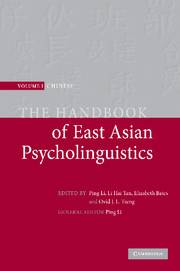Book contents
- Frontmatter
- Contents
- List of figures
- Notes on contributors
- Preface
- Introduction: new frontiers in Chinese psycholinguistics
- Part I Language acquisition
- 1 Actions and results in the acquisition of Cantonese verbs
- 2 Chinese children's knowledge of the Binding Principles
- 3 Chinese classifiers: their use and acquisition
- 4 Child language acquisition of temporality in Mandarin Chinese
- 5 Second language acquisition by native Chinese speakers
- 6 Making explicit children's implicit epilanguage in learning to read Chinese
- 7 Emergent literacy skills in Chinese
- 8 Basic syntactic categories in early language development
- 9 Growth of orthography-phonology knowledge in the Chinese writing system
- 10 Interaction of biological and environmental factors in phonological learning
- 11 The importance of verbs in Chinese
- 12 Grammar acquisition via parameter setting
- 13 Early bilingual acquisition in the Chinese context
- Part II Language processing
- Part III Language and the brain
- Epilogue: a tribute to Elizabeth Bates
- References
- Name index
- Subject index
1 - Actions and results in the acquisition of Cantonese verbs
Published online by Cambridge University Press: 05 June 2012
- Frontmatter
- Contents
- List of figures
- Notes on contributors
- Preface
- Introduction: new frontiers in Chinese psycholinguistics
- Part I Language acquisition
- 1 Actions and results in the acquisition of Cantonese verbs
- 2 Chinese children's knowledge of the Binding Principles
- 3 Chinese classifiers: their use and acquisition
- 4 Child language acquisition of temporality in Mandarin Chinese
- 5 Second language acquisition by native Chinese speakers
- 6 Making explicit children's implicit epilanguage in learning to read Chinese
- 7 Emergent literacy skills in Chinese
- 8 Basic syntactic categories in early language development
- 9 Growth of orthography-phonology knowledge in the Chinese writing system
- 10 Interaction of biological and environmental factors in phonological learning
- 11 The importance of verbs in Chinese
- 12 Grammar acquisition via parameter setting
- 13 Early bilingual acquisition in the Chinese context
- Part II Language processing
- Part III Language and the brain
- Epilogue: a tribute to Elizabeth Bates
- References
- Name index
- Subject index
Summary
Acquisition of Cantonese syntax has received relatively little attention up till now. The first known work is Li's (1968) thesis on the development of her little sister's syntax in Cantonese from the age of 1;6 to 2;6 in the context of Malaysia. The data currently available on the early acquisition of Cantonese consist of longitudinal observations (Leung, 1996; Lee et al., 1996); some cross-sectional elicitation studies of the comprehension or production of forms such as locative phrases (Cheung, 1991a) and wh-words (A. Cheung & Lee, 1996); and a few experimental studies that rely on grammaticality judgments and revisions (Tsang & Stokes, 2001), and on uses of novel verbs to elicit grammatical constructions (Cheung & Brooks, 2002).
In this chapter we focus on children's development of expressions for talking about actions and results. We first provide a general characterization of those Cantonese structures relevant to our discussion of the acquisition studies.
General characterization of Cantonese
Cantonese, in its broad sense, refers to a family of related Chinese dialects spoken in Hong Kong, Macau, the province of Guangdong, the southern region of the province of Guangxi, and many ethnic Chinese communities around the world. In this broad sense, there are over 70 million Cantonese speakers worldwide (Grimes, 2000). The term Cantonese is also used to refer specifically to the varieties of Cantonese spoken in Hong Kong and Guangzhou (the city of Canton).
- Type
- Chapter
- Information
- The Handbook of East Asian Psycholinguistics , pp. 13 - 22Publisher: Cambridge University PressPrint publication year: 2006
- 4
- Cited by



